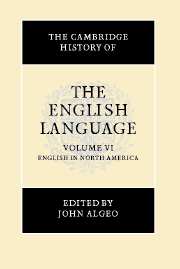Book contents
- Frontmatter
- 1 EXTERNAL HISTORY
- 2 BRITISH AND AMERICAN, CONTINUITY AND DIVERGENCE
- 3 BRITISH AND IRISH ANTECEDENTS
- 4 CONTACT WITH OTHER LANGUAGES
- 5 AMERICANISMS
- 6 SLANG
- 7 DIALECTS
- 8 AFRICAN-AMERICAN ENGLISH
- 9 GRAMMATICAL STRUCTURE
- 10 SPELLING
- 11 USAGE
- 12 CANADIAN ENGLISH
- 13 NEWFOUNDLAND ENGLISH
- 14 American English Abroad
- Glossary of Linguistic Terms
- Bibliography
- Index
- THE CAMBRIDGE HISTORY OF THE ENGLISH LANGUAGE
13 - NEWFOUNDLAND ENGLISH
Published online by Cambridge University Press: 28 March 2008
- Frontmatter
- 1 EXTERNAL HISTORY
- 2 BRITISH AND AMERICAN, CONTINUITY AND DIVERGENCE
- 3 BRITISH AND IRISH ANTECEDENTS
- 4 CONTACT WITH OTHER LANGUAGES
- 5 AMERICANISMS
- 6 SLANG
- 7 DIALECTS
- 8 AFRICAN-AMERICAN ENGLISH
- 9 GRAMMATICAL STRUCTURE
- 10 SPELLING
- 11 USAGE
- 12 CANADIAN ENGLISH
- 13 NEWFOUNDLAND ENGLISH
- 14 American English Abroad
- Glossary of Linguistic Terms
- Bibliography
- Index
- THE CAMBRIDGE HISTORY OF THE ENGLISH LANGUAGE
Summary
Early Newfoundland
Varieties of English have been established in Newfoundland since the early seventeenth century, when small numbers of men began to live year-round near the cod fisheries of the island's coastal waters and the adjacent Grand Bank and when scattered families were established in coastal settlements after the arrival of a few women. The first English birth on the island was recorded in 1613. However, annual fishing voyages had brought Englishmen and other European nationalities to the Newfoundland coasts since at least 1497 (Cell 1969). Several adventurers, for example George Calvert, later Lord Baltimore, attempted to plant colonies in the early decades of the 1600s, but as these did not persist as discrete communities beyond the middle of the seventeenth century, there is little firm documentation about colonists who may have become settlers, married, and produced lines of descendants (Cell 1982).
The island of Newfoundland lies in the mouth of the St. Lawrence River, to the south of Quebec and Labrador. It is the size of the state of Tennessee, and coastal Labrador, which falls within its jurisdiction, is nearly as large as Arizona. Basic to an understanding of the establishment of English in the island of Newfoundland is that from the sixteenth to the late eighteenth century, though with interruptions in wartime, it was visited in the summers by thousands of transient fishermen from the southwestern counties of England. At the same time, it was occupied year-round by a strikingly small number of settlers, likewise from the same West Country sources (L. Harris; O'Flaherty; Story).
- Type
- Chapter
- Information
- The Cambridge History of the English Language , pp. 441 - 455Publisher: Cambridge University PressPrint publication year: 2001
- 5
- Cited by



